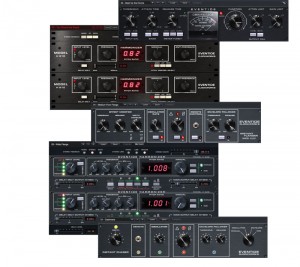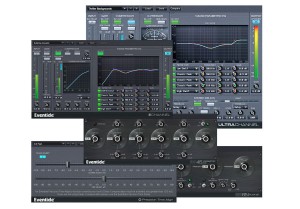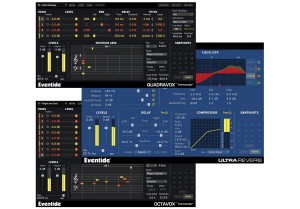New Software Review: Eventide Anthology X Bundle
In today’s studios we often have more pitch-shifting, delay and reverb options at our disposal than we know what to do with. I know that some of my many plug-ins may sit unused for months at a time, only to re-emerge in a sudden flash of discovery, prompting me to ask “well, where did you come from then?”
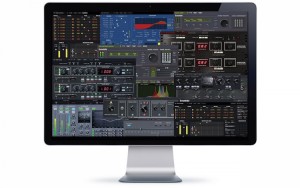
Eventide’s Anthology X bundles the effects that made them world-famous, with new, next generation processors.
But there was a time, way back when, that a small company called Eventide was pioneering so much of this technology that we now take so much for granted, that once groundbreaking effects can be found as basic presets on even the lowliest of DAWs (The “monster voice” on Garageband comes quickly to mind).
Still, there is something so classic, familiar and authentic about the early Eventide effects, as we have heard them on some many of our favorite records of the past three to four decades.
The Eventide Anthology X takes all the rich history of the company and serves it up in one terrific plug-in package. Included in this are the “legacy” items such as the H910 and H949 Harmonizers, classic phasers, the not-as-well known Omnipressor, and many others.
Of course, the legendary H3000 Ultra-Harmonizer sits firmly as the crown jewel of this package, continuing its legacy as a studio staple even in the DAW era. Also included is a mixing/mastering bundle and some of what Eventide calls “next generation effects”—those tools that have become a staple of their business in the last few years.
Nearly all these plug-ins aside from the “next generation” offerings are included in the TDM Anthology II bundle, and I will attempt to keep the remarks on all these plug-ins short and sweet.
Jumping in to the oldies: “The Clockworks Legacy”
H910 & H949
There’s a good reason we should be excited about the inclusion of the H910 and 949 in the Anthology X bundle. Even though original units can be found for fair sums on eBay and the like, the truth is that if one of them breaks on you, well, good luck getting it fixed.
I know this personally from the experience of tirelessly asking fellow engineers “Ummm, hey, know a place I can get this H949 fixed?” of which the consensus seems to be that ”not a soul can fix them.” Whether or not this is totally correct, suffice it to say that it’s nice to have these classics in plug-in format.
The 910 and 949 both have a great, simple layout, and are endlessly fun to engage with. The controls and functions of these machines are pretty basic, so there’s not much to guess about here. From small delays and micro-shifts in pitch to extreme settings (and even a de-glitch button on the 949 to deal with the artifacts sometimes inherent in these old machines) they can create a wide range of iconic sounds with surprisingly few controls.
Also included are presets such as the dual 910 and 949’s, an old trick used in the 70’s where L and R channels were given slight differences in delay or pitch or order to widen the stereo field or sound source.
Omnipressor
One of my personal discoveries on this trial however was the Omnipressor. Reviewed extensively in Sonic Scoop 2012, it really is a unique compressor. A bit of an odd duck when it came out, and apparently slagged off by engineers who thought it was not quite up to standards, in our era of endless high-end, super-smooth compressor models, it certinaly stands out.
My first instinct was to use it as a parallel drum buss compressor and it completely kicked the ass of a good old rock n’ roll mix I was working on. My inclination is to use this more compressor more as an effects processor rather than for the polite compression we sometimes want. But then again, radical effects processing is where Eventide really shines, so it is in some sense a perfect fit for the brand. Like so much of the Eventide line, it is unique and interesting starting points for those looking to dip their toes into something a bit more “other-worldy.”
Instant Flanger and Instant Phaser
Also included are our old friends, Flanger and Phaser, based on some of the very first ones ever designed. Both have quite comprehensive interfaces, and offer mono or stereo operation, which was not available on the original hardware. I found the presets on this to be really fun, especially when pursuing the iconic Kashmir settings on the phaser, and when dialing in sounds ranging from the underwater to the lightly-widened on the flanger.
H3000 Collection
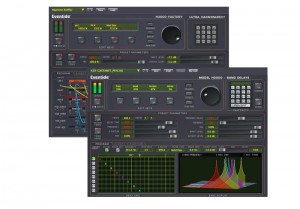
The plugin version of the H3000 makes complex routing easier than ever, and adds on a powerful “Band Delays” iteration of this iconic device.
I will admit it: I was a huge Steve Vai nerd in high school. The H3000 processor was not unknown to me even back then, and I was always enamored by it. (“What IS it doing!?’ What are those sounds!?’) In my more “purist” guitar-nerd days in college, I eschewed nearly all processing, only to rediscover and fully embrace my love for the H3000 in later years as a Brian Eno-devotee.
The bottom line is, the H3000 is a story in its own. As ubiquitous (and often unused) it may be, the full capacity of this machine is mind-boggling. And it only gets deeper and more mind-bogglingly powerful in plug-in form.
Of course, there is a list of all the regular H3000 factory presets in here—your pitch shifting/crystallizing sounds, epic reverbs, legacy items (already a legacy back then!), distortions, LP and HP filters, and honestly, more than this article can even get in to. My recommendation to you: Spend some quality time with your H3000. There are sounds and settings just waiting to be discovered.
The aspect that makes this plugin version so amazing are the extensive routing options available on the lower portion of the plug in. Yes, these were options always available on the hardware device, but for a mere mortal such as myself, I always found the routing options on the hardware to be mysterious and far more trouble (and cabling) than they were worth. Not to say that it’s necessarily simple on the software version, but if you have a very basic understanding of signal flow and modular synthesis, these options can open up a whole new sonic world with far less fuss than the original hardware.
Also included is the H3000 “Band Delays” plug in. It is essentially a version of the H3000 that is focuses its energies on tempo-based multi-tap delays, and has a very similar layout to the regular H3000 plug-in. The filters on these presets can easily be “played” or controlled via midi, making it a far more interactive experience.
Mixing and Mastering Bundle
To add to the wild processing potential of the classic Eventide effects, the Mixing and Mastering bundle in Anthology X offers a nice side-helping of some very usable plug-ins of a more “general” variety.
I’ll start with the UltraChannel, which essentially puts several powerful and essential processors into one big channel strip. Here, we’ve got a gate, an omnipressor AND a compressor (both with sidechain options), a 5 band EQ, micro pitch shift and L/R Stereo Delays.
It’s a terrific plug in for a track that might typically need several processors working together, such as on a pop vocal. As might be expected, it takes up quite a bit of processing power, so it’s not for use on every track.
The included EChannel is a great alternative for when you still need several effects, but not at the full scale of the UltraChannel . It is kind of a “best of” the Ultra Channel, and may be useful in more situations. I found both of these plug ins useful for tracks that need trimming in a few areas, but for tracks that need a lot of heavy processing I’d be more inclined to go with separate plug-ins for each effect.
Next up are two somewhat similar classic parametric EQs: the EQ 65 and EQ45, a 6 and 4 band EQ respectively, both with variable low and hi cut filters. I have never been a huge fan of the idea of digital interfaces that mimic hardware EQs, but in just a little time working with these, I found myself adopting a very similar approach to the one I take when working with outboard EQs, and enjoying it thoroughly. As much as I love the ability to zero in on every little band frequency with my modern digital EQ displays, I have to admit that there’s something very intuitive about sweeping through bands without an overly graphic interface clouding up your visual cortex, and it is great to have an EQ with this kind of retro interface in the arsenal.
Last in the Mixing and Mastering category we have two unsung heroes of audio engineering: Time Align and Time Delay. They both do exactly what you may imagine, allowing you to adjust your tracks by positive or negative samples in order to match line them up or to fix possible phase issues by ear. As far as I can tell, the difference between the two lies in whether or not you use delay compensation while mixing. Being that I have mine on almost always, I was able to use just the regular Time Align no problem. Most often, I prefer to work in the regular Pro Tools nudge mode for lining up sounds, occasionally relying on the amazingly useful “Auto Align” plugin by SoundRadix, but it is nice to have an extra tool like this one, that encourages listening over looking, allowing your ears to be the guide.
Next Generation FX
Eventide have never been a company to simply rest on its laurels, and in the past few years it seems as though they have started to really extend themselves into new fields.
The latest rash of Eventide stompboxes, plug-ins and the H8000FW have all proven that Eventide is still coming up with great new algorithms. So, why not include some of these modern classics in this bundle?
One of the cooler new effects included here is the Octavox, originally part of the H8000 presets, but now laid out here in what may be its best form yet. As you look at the interface, you will see a treble and bass clef on which you can place up to 8 notes of harmonizing. You can create monstrous tone clusters, beautiful multi-octave shimmers, or just about anything you can dream of. The Quadravox is a simplified and less CPU-intensive version of the Octavox, for us simple folk who may just want to add 4 layers of extra harmonizing.
Lastly, we have the UltraReverb channel. It’s hard to imagine that you may need more reverbs than the H3000 already has, but this little plug-in offers a lot of worthwhile features including a built in EQ for the reverb, a compressor, and all the typical features you’d expect to find in a reverb algorithm such as decay time, room size, and a very cool “lo-fi” switch. A delay module is also included, which can add a little bit of slap, post-reverb, to your signal.
I found the presets here to be a great starting point and there are so many flavors to choose from. Some of the plates are just perfect, the halls are epic, and the “FX” section is just downright strange in the kind of way you’d only expect from Eventide. The “cold fusion” setting had me scratching my head in the best possible way, as it sounded like a confused Christian Fennesz trying to escape a windstorm.
In Use
As mentioned at the start, there is no shortage of plug-ins out there that do things similar to these. But imagine this: You get nearly everything Eventide has put out in the last 40 years for the price of a single H3000. (Never mind the hassle of finding someone to fix the machine if it has even a slight glitch.) Plus, you’re getting all this from the company who has been pioneering digital effects from the moment it was possible.
In use, I found these plug-ins to be just as engaging and engrossing as the hardware. Having owned some of these models before, I did miss a bit of the random spinning of the scroll wheel I could do when totally lost on where to go with a sound, but the level of detail to which you can sculpt with these plug-ins made me forget that issue instantly. But perhaps a “randomize” or “scroll aimlessly” function could be included in the next version to bring back some of the roulette-like fun of the original hardware versions.
I think my favorite thing about the bundle, however, is the inclusion of a mix blend control on every plug in. Thank you Eventide! Because reaching the right balance against the original source is such a crucial part of working with effects, a mix knob is a dream, especially when dealing with one-off inserts. I wish all effects everywhere had a blend option, and fortunately, more and more, like the Anthology, do.
Another welcome feature across the board is that Eventide really provides great jumping-off points into further sonic explorations, and their many carefully-crafted presets are a great place to start that jump. This is not a collection of plug ins that says ”hey, come sound like these old records” but rather a collection that provides engineers and producers with tools that are both incredibly useful and very creative.
As for me, I found myself having a ton of fun trying these algorithms out on nearly everything I could, even texting SonicScoop editor Justin Colletti that “I may not leave the studio for a week” when I first loaded in the Eventide Anthology X bundle.
From kick drums with crystal preset, to bass guitars panned with an H949 dual, cymbal crashes harmonized in clusters, and reverse compression whatever I could, I was—and still am—discovering lots of great uses for these plug ins every day. I think the Eventide Anthology X is a great deal for anyone even remotely interested in the world of Eventide or in extreme effects in general.
Rich Bennett is an engineer, producer, composer, and guitarist who grew up in New York City. He is the owner of Acme Hall Studios, a recording studio and music education space in Park Slope, Brooklyn.
Please note: When you buy products through links on this page, we may earn an affiliate commission.







